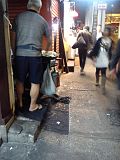The Cartful
The Cartful 車仔檔 , also known as portable stall and mobile stall, is a style of hawker stall originated from the street vendors selling inexpensive street food, like eggette, Tang Cong Bing 糖葱餅, and cart noodle, in the 1950s.This style of selling is part of Hong Kong traditional culture. It reflects people’s way of living and their spirits. In recent years, the operation of the cartful faces challenges due to the government policies and modernization.
History
Hong Kong has been experiencing economic downturn in the 1950s, meanwhile, refugees from the Mainland fled to Hong Kong constantly after the establishment of The People's Republic of China, leading to an increase in population. People struggled to make a living, they started to operate mobile stall using wooden carts with a low production cost.[1] With the portable carts, street vendors could get away in time from being arrested by the police. In the 1970s and 1980s, a wide variety of products are sold then. Besides food and snacks, household goods, clothing and kitchenware could be found in the carful in place like Sham Shui Po.[2]
Features
The cartful sells mainly two kinds of products, street food and clothes. Some traditional street food such as eggette, curry fish balls and fried chestnuts are favored by teenagers. These $10-odd snacks are cheap but delicious. They smell very nice so that they drive people queuing for them. The cartful owners make the snacks once they are ordered so as to keep them hot and fresh. Apart from the street snacks, the carful also sells clothes, sometimes handbags. Women love buying free-sized legging and socks. Though customers cannot try fitting the products, they are willing to buy them.
Owners and locations
There are mainly two types of owners which are the unemployed middle-aged and the unlicensed hawkers. Both of them are the main support of their family while they cannot find a suitable job. As a result, they choose to run the carful because it can help them make a decent living and avoid the high rent. The carful of these kinds are operated by family units. Most of the cartful can be found near the public housings, schools and MTR stations, because a steady stream of people from these places can help increase their business turnover.
Relationship with Hong Kong
The cartful fully reveals Hong Kong spirits:[3] diligence and fast paced lifestyle. With a small amount of capital and time, owners can earn huge profit from the whole day sales by moving their cart around without paying high rent. This traditional hawking style is threatened because of the government policy and modernization. As the law [4] prohibits unlicensed hawking, many mobile stalls have been demolished. Yet, the government sets up markets in different districts like Tin Sau Hui Chinese: 天秀墟] and Wan Chai Tai Yuen Street Chinese: 原街] in order to gather the mobile stalls. Some of the citizens support the government plan since they think it is hygienic and peaceful without the mobile stalls on street, while others object to the cruel government policy due to the reminiscence of the cartful.[5][6][7]
The Cartful Media
References
- ↑ 它嗱喳,但好吃。——車仔麵 東方日報
- ↑ 深水埗歷史
- ↑ Hong Kong Spirit Archived 2013-04-12 at the Wayback Machine Hong Kong Spirit Ambassadors Limited
- ↑ CONTROL OF LICENSED AND UNLICENSED HAWKERS Food and Environmental Hygiene Department
- ↑ 走入灣仔大街小巷 吃出飲食文化變遷 Archived 2016-03-03 at the Wayback Machine 文匯報
- ↑ "灣仔太原街". Archived from the original on 2007-09-27. Retrieved 2013-04-09.
- ↑ Lau, Kit (2012). Mobile Delights by the Cartful 車仔檔(英文版). Joint Publishing HK. ISBN 9789620432071.

